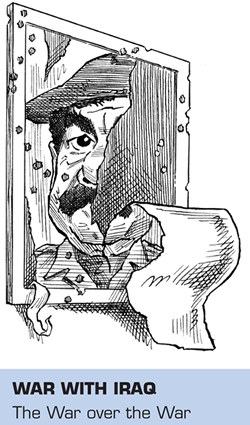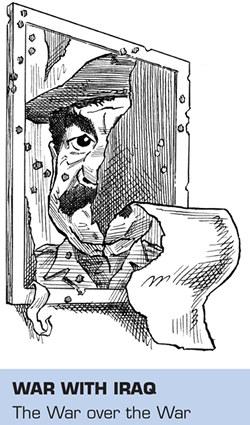- Security & Defense
- US Defense
- International Affairs
In a speech at West Point on June 1, 2002, President Bush

explained that the “gravest danger to freedom lies at the crossroads of radicalism and technology.” He promised to oppose “with all our power” efforts by terrorists and states to use modern weapons to advance radical aims by attacking the United States or its allies. Where necessary, he would resort to preemptive actions, rather than permit the devastating consequences that can flow from attacks such as those carried out on September 11, 2001.
The United States and its allies have now concluded just such a preemptive action, toppling the regime of Saddam Hussein in a three-week war in Iraq. The president argued that the war was necessary for our own security, and, as polls indicated, a majority of the American people agreed. But what about international law? Was the war in Iraq legal?
Indeed it was. Although the use of force in Iraq was not explicitly approved by the U.N. Security Council, the combination of resolutions adopted regarding Iraq established a strong basis upon which to justify the use of force. This is the principal basis on which the administration has properly relied in justifying its actions under international law. The administration has also properly invoked the inherent right of self-defense in using force against Iraq, despite the absence of an “imminent” threat of attack. This, too, is a proper basis for action against Iraq, taking into account all the properly relevant considerations.
The U.N. Charter cannot and should not be read to restrict the use of force in self-defense to situations of “imminent” attack. Rather, fundamental principles of international law and the values expressed in the United Nations Charter establish that the standard for the use of force is “necessity,” which is determined by four factors: (1) the nature and magnitude of the threat involved; (2) the likelihood that the threat will be realized unless preemptive action is taken; (3) the availability and exhaustion of alternatives to using force; and (4) whether using preemptive force is consistent with the terms and purposes of the U.N. Charter and other applicable international agreements.
Let’s apply these criteria to the war in Iraq.
1. The threat. Saddam Hussein’s Iraq possessed chemical and biological weapons. They were difficult to detect and their use could have inflicted massive casualties. Saddam Hussein also had a history of supporting terrorists, particularly Abu Nidal and his organization and PLO terrorist Abu Abbas. Hussein also employed terrorists in an attempt to assassinate the first President Bush. (Abu Abbas was picked up by American troops in Baghdad in mid-April. Abu Nidal was said to have committed suicide in Baghdad before the war by firing three bullets into his own head.)
Saddam Hussein also posed a continuing threat in light of his prior conduct and avowed motives. He had twice invaded neighboring states in pursuit of his avowed aim of “reestablishing” the “Arab Nation” with its capital in Baghdad. These invasions caused more than 800,000 deaths. If Iraq had been allowed to continue to develop weapons of mass destruction, including nuclear arms, it could have used or threatened to use those arms to disrupt or derail international efforts to prevent it from achieving its geopolitical objectives.
The magnitude of the threat posed by Saddam Hussein’s Iraq was potentially very great, both physically and economically. Its forces and weapons programs had the ability to inflict massive casualties and cause grave disruption. The effects of a major attack on the Hussein regime’s most likely targets, Kuwait and Israel, could have been potentially horrendous, given their vulnerability and relatively small, geographically concentrated populations.
2. Likelihood of the threat being realized. Any doctrine that allowed states to use force to prevent merely the potential development of a threat would wreak havoc on international security. Yet there was considerable evidence to support the likelihood of further Iraqi aggression if Saddam Hussein had been allowed to continue to develop weapons of mass destruction. In principle, Saddam Hussein should have been averse to confronting superior forces, but his policies were frequently not based on rational calculation. Ambassador Joseph Wilson, a former U.S. diplomat who had extensive contact with Saddam Hussein and Iraq, reported that he “learned firsthand . . . what the CIA psychiatrists have said for years: Saddam is an egomaniacal sociopath whose penchant for high-risk gambles is exceeded only by a propensity for miscalculation.”
The threat posed by Saddam Hussein was also based on his perversity, as reflected in his willingness to inflict wanton destruction having no rational purpose. The egregious violations of human rights conducted by his regime are well known. He used chemical weapons against Kurdish Iraqis, killing thousands of civilians, and against Iranian troops. He deliberately spilled tens of millions of barrels of oil into the Kuwaiti desert and the Gulf and set fire to 720 Kuwaiti oil wells when he realized he had been defeated in the first Gulf War. Based on this record, President Bush reasonably concluded that the threat posed by Saddam Hussein was both grave and highly likely to be realized, even though it may not have been imminent.
3. Exhaustion of alternatives. The Security Council had imposed economic sanctions and other penalties on Iraq for more than 10 years in some 16 resolutions. It gave Iraq a final opportunity, in Resolution 1441, to comply with outstanding Security Council resolutions, including those related to the development of weapons of mass destruction. It is difficult to claim that the United States failed to exhaust all reasonable, alternative means for securing compliance short of force. Even if some states genuinely believed that Iraq’s disarmament could have been achieved through inspections and pressure, this view was based on very little evidence and on the impractical assumption that the United States and its allies could afford to position their armed forces in preparation for an attack indefinitely.
4. Consistency with charter purposes. Article 2(4) of the U.N. Charter calls on member states to refrain from the threat or use of force against the territorial integrity or political independence of any state, or “in any other manner inconsistent with the purposes of the United Nations.” This principle has generally been claimed to apply to all uses of force, whatever their purpose. But that position has never made sense in light of the need to achieve the charter’s purposes.
It is unreasonable to refuse to give weight to Security Council actions in evaluating the need (and hence the legality) for using force merely because the Security Council may not have granted explicit authority. In the case of Kosovo, for example, it was significant that the council found Serbia to have acted illegally in several respects, in ways that were a threat to international peace and security under Chapter VII; that Serbia had failed to comply with the council’s orders to stop such actions; that the council had imposed economic and other sanctions on Serbia for its violations of council resolutions and international law; and that it had set up a tribunal to try cases against leaders who violated important humanitarian prohibitions. All these findings and conclusions supported the propriety of NATO’s resort to force.
Despite the fact that the Security Council failed to grant members explicit authority to use force against Iraq, the council’s findings, conclusions, and other actions should nevertheless be given proper weight in evaluating the propriety of an enforcement action in Iraq. Resolutions adopted by the council to end the Gulf War were explicitly conditioned on Iraq’s agreeing to give up its weapons programs and to comply with other demands. Arguably, the breach by Iraq of those resolutions restored in full force the original authorization by the council for the use of force in 1990. In addition, numerous findings in resolutions, including Resolution 1441, condemned Iraq for violating council resolutions and for egregious breaches of international law, including disregarding fundamental human rights. Saddam Hussein’s regime had also violated other international agreements, including those prohibiting the development of chemical and biological weapons. When these considerations are taken into account, the case for disarming Iraq without further U.N. authorization was strong and widely supported by government lawyers and statesmen.
Preemption must be considered responsibly, on a case-by-case basis, but it remains one aspect of every government’s duty to protect its people. Weapons of mass destruction (the very possession of which may be illegal) can now be fashioned by many states and delivered in many ways. When such weapons are likely to be used by a state, directly or through surrogates, and all reasonable means short of force have been exhausted, it is reasonable to expect target states to consider preemption. In the war in Iraq, each of these tests was met.
















